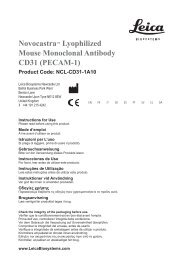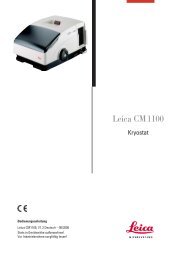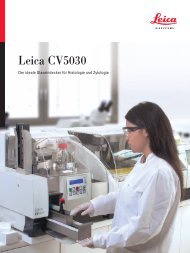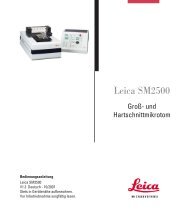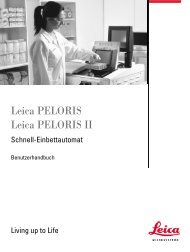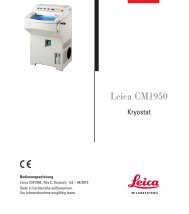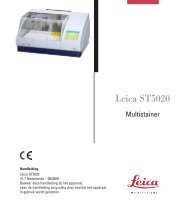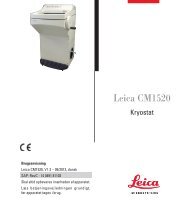Info - Leica Biosystems
Info - Leica Biosystems
Info - Leica Biosystems
You also want an ePaper? Increase the reach of your titles
YUMPU automatically turns print PDFs into web optimized ePapers that Google loves.
Quality Control<br />
Differences in tissue processing and technical procedures in the user’s laboratory may produce significant variability in results,<br />
necessitating regular performance of in-house controls in addition to the following procedures.<br />
Controls should be fresh autopsy/biopsy/surgical specimens, formalin-fixed, processed and paraffin wax-embedded as soon as possible<br />
in the same manner as the patient sample(s).<br />
Positive Tissue Control<br />
Used to indicate correctly prepared tissues and proper staining techniques.<br />
One positive tissue control should be included for each set of test conditions in each staining run.<br />
A tissue with weak positive staining is more suitable than a tissue with strong positive staining for optimal quality control and to detect<br />
minor levels of reagent degradation. 2<br />
Recommended positive control tissue is placenta.<br />
If the positive tissue control fails to demonstrate positive staining, results with the test specimens should be considered invalid.<br />
Negative Tissue Control<br />
Should be examined after the positive tissue control to verify the specificity of the labeling of the target antigen by the primary antibody.<br />
Recommended negative control tissue is skeletal muscle.<br />
Alternatively, the variety of different cell types present in most tissue sections frequently offers negative control sites, but this should be<br />
verified by the user.<br />
Non-specific staining, if present, usually has a diffuse appearance. Sporadic staining of connective tissue may also be observed in<br />
sections from excessively formalin-fixed tissues. Use intact cells for interpretation of staining results. Necrotic or degenerated cells often<br />
stain non-specifically. 3 False-positive results may be seen due to non-immunological binding of proteins or substrate reaction products.<br />
They may also be caused by endogenous enzymes such as pseudoperoxidase (erythrocytes), endogenous peroxidase<br />
(cytochrome C), or endogenous biotin (eg. liver, breast, brain, kidney) depending on the type of immunostain used. To differentiate<br />
endogenous enzyme activity or non-specific binding of enzymes from specific immunoreactivity, additional patient tissues may be stained<br />
exclusively with substrate chromogen or enzyme complexes (avidin-biotin, streptavidin, labeled polymer) and substrate-chromogen,<br />
respectively. If specific staining occurs in the negative tissue control, results with the patient specimens should be considered invalid.<br />
Negative Reagent Control<br />
Use a non-specific negative reagent control in place of the primary antibody with a section of each patient specimen to evaluate<br />
non-specific staining and allow better interpretation of specific staining at the antigen site.<br />
Patient Tissue<br />
Examine patient specimens stained with NCL-L-CD163 last. Positive staining intensity should be assessed within the context of any<br />
non-specific background staining of the negative reagent control. As with any immunohistochemical test, a negative result means that<br />
the antigen was not detected, not that the antigen was absent in the cells/tissue assayed. If necessary, use a panel of antibodies to<br />
identify false-negative reactions.<br />
Results Expected<br />
Normal Tissues<br />
Clone 10D6 detected the CD163 protein in the membrane and cytoplasm of monocytes and macrophages. Staining was noted<br />
particularly in red pulp macrophages in the spleen, interfollicular macrophages and sinus histiocytes in lymph node, interfollicular<br />
dendritic cells in tonsil, alveolar macrophages in lung, Kupffer cells in the liver and Hofbauer cells in placenta. Some weak staining was<br />
noted within kidney tubules and nerve fiber granularity within the molecular layer of cerebellum. No staining was observed in follicular<br />
dendritic cells in tonsil and lymph nodes. (Number of normal cases evaluated = 43).<br />
Abnormal Tissues<br />
Clone 10D6 demonstrated some weak staining in 3/4 lung tumors (including 1/1 adenocarcinoma, 1/1 squamous cell carcinoma, 1/1<br />
large cell carcinoma and 0/1 non-small cell carcinoma), 2/2 testicular seminomas, 1/4 papillary carcinomas of the thyroid, 1/2 squamous<br />
cell carcinomas of the tongue, 1/2 squamous cell carcinomas of the esophagus, 1/2 metastatic tumors of unknown origin and 1/1<br />
squamous cell carcinoma of the larynx. Except for infiltrating macrophages, no staining was observed in 167 lymphomas (including<br />
diffuse large cell B-cell lymphomas (0/107), chronic lymphocytic lymphomas (0/12), follicular lymphomas (0/11), Hodgkin’s disease<br />
(0/11), mantle cell lymphomas (0/7), T-cell anaplastic large cell lymphomas (0/7), angioimmunoblastic T-cell lymphomas (0/4), T/NK cell<br />
lymphomas (0/3), a B-cell acute lymphoblastic lymphoma (0/1), a Primitive B/T cell acute lymphoblastic lymphoma (0/1), a peripheral<br />
T-cell lymphoma (0/1), a T-cell lymphoma (0/1), and a marginal zone lymphoma (0/1)). No staining was observed in liver tumors (0/4),<br />
ovarian tumors (0/4), colorectal tumors (0/4), stomach tumors (0/2), tumors of the cervix (0/2), breast tumors (0/2), skin tumors (0/2),<br />
renal tumors (0/2), brain tumors (0/2), soft tissue tumors (0/2) and a tumor of the thymus (0/1). (Total number of abnormal cases<br />
evaluated = 211).<br />
NCL-L-CD163 is recommended for the assessment of CD163 protein expression in normal and neoplastic tissues.<br />
General Limitations<br />
Immunohistochemistry is a multistep diagnostic process that consists of specialized training in the selection of the appropriate reagents;<br />
tissue selection, fixation, and processing; preparation of the IHC slide; and interpretation of the staining results.<br />
Tissue staining is dependent on the handling and processing of the tissue prior to staining. Improper fixation, freezing, thawing, washing,<br />
drying, heating, sectioning or contamination with other tissues or fluids may produce artifacts, antibody trapping, or false negative<br />
results. Inconsistent results may be due to variations in fixation and embedding methods, or to inherent irregularities within the tissue. 4<br />
Excessive or incomplete counterstaining may compromise proper interpretation of results.<br />
The clinical interpretation of any staining or its absence should be complemented by morphological studies using proper controls and<br />
should be evaluated within the context of the patient’s clinical history and other diagnostic tests by a qualified pathologist.<br />
Antibodies from <strong>Leica</strong> <strong>Biosystems</strong> Newcastle Ltd are for use, as indicated, on either frozen or paraffin-embedded sections with specific<br />
fixation requirements. Unexpected antigen expression may occur, especially in neoplasms. The clinical interpretation of any stained<br />
tissue section must include morphological analysis and the evaluation of appropriate controls.<br />
CD163-L-CE<br />
Page 3



